Last Updated on March 15, 2024 by Masha Eretnova

Ebru art appeared a long time ago. Traditional ebru is a mysterious and beautiful art but today it’s available for all levels of creative souls and you can even learn how to do ebru painting at home!
Imagine – painting ON water but then transferring it onto paper – pure magic tricks!
To start Ebru painting you need a tray with prepared water, special brushes, marbling paint, and marbling paper to transmit your painting. You apply paint onto the surface of water, create designs with combs and brushes and then lay the paper over to transfer the painting.
What exactly do you need and where to buy all the needed ebru materials, check this post. Plus, I’d like to briefly introduce you to the history of ebru – you will be very surprised! And also with a simple How to Paint Ebru guide. Enjoy!
Table of Contents
This article contains affiliate links. It means no extra cost for you but a little commission (2-3%) for me to support my hobby and blog. Thank you!
What is Ebru?
Marbling art is also well-known as ebru painting. It is magic happening on the water surface, meditation, and creativity at once.
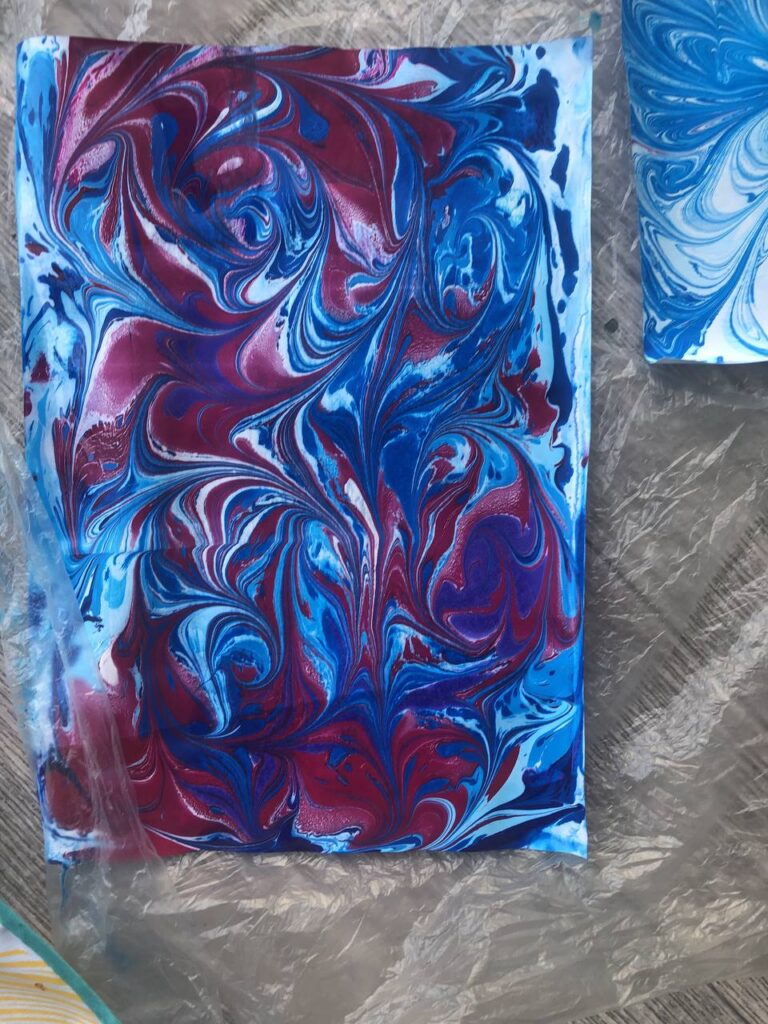
Ebru is a very old and mysterious Turkish tradition of painting on oily water and then transferring the painting to the paper.
In older times, Marber or Ebru painter used natural colors and organic pigments and mixed them with ox-gall (as a wetting agent).
They sprinkle and brush the colors onto water mixed with powdered gelatin – Carrageenan powder, which forms the “size” on which the colors float. With special tools, they created shapes, lines, patterns, flowers, and beautiful paintings.
They transmitted their knowledge only orally and with training. Even today, some techniques still remain secret.
Ebru is not just a painting technique, it is a tradition, a part of the culture, a philosophy. Ebru is included in UNESCO’s cultural heritage.
Back in the 17th century, ebru was used as background painting for official documents and papers to prevent fake copies.
Later, Europeans, especially Italians popularized ebru and marbling and it is still popular and extremely precious nowadays.
Today marbling is used on many surfaces, not only traditional water but on the body, glass, fabric, rocks, paper, etc. Even 3D ebru exists nowadays.
Essential Ebru Supplies
The basic ebru technique means: that you have a tray with a mixture of oily water, and you add drops of paint (made to float on the surface) onto the surface of the water, creating patterns by adding colors and using tools, like a stylus or comb. Once you’ve done it, transfer the painting to the paper.
The painting process needs control, tranquility and concentration. It is a creative meditation.
Ebru painting starter kit includes:
| Essential ebru painting materials | Extra ebru supplies |
|---|---|
| tray with lid marbled papers marbling paints marbling liquid ( Distilled water + carrageenan) ox gall marbling comb ebru needle tool | alum brushes disposable plastic apron disposable plastic tablecloths hand marbled samples turpentine burnishing tool |
Tray with lid

Basically, the ebru tray is a large container, a basin, where you will pour the premixed water and paint onto it. When you buy an Ebru kit, you will get one included.
You can also always use a normal plastic, metal, glass, or wood container, large enough for painting. It has to be 1-2 cm longer on each side than the size of the paper you will paint onto.
Usual tray sizes: A4, 25×35, A3, 35×50, 50×70, 70×100. The average depth is 5 cm.
Marbling liquid
In the tray, you need to add special water. You can’t just use tap water, paint will not sit on top of it without changing shapes and dissolving.
For ebru painting you need a special marbling size or liquid – usually, you will mix Carrageenan powder with distilled water and leave for a few hours or 1 day to rest.
Recipe: Blend 2 1/2 tablespoons of carrageenan powder for 1 gallon of water.
Marbling size should not contain any bubbles or foam. You need to filter it before use and add some water if needed.
I saw how marblers premix the solution in huge 20L bottles and just use it when they need it.
Alternatives to carrageenan powder are Tragacanth, flaxseed, saleb (orchid extract), quince seed, Fenugreek seeds, starch, etc. The results of each differ in quality.
If you will purchase a full starter pack, you will have all you need to mix marbling liquid. If you want to purchase carrageenan powder separately, try Jacquard Carrageenan (around $40 for 8oz) or Marbling Concentrate by Handy Art (much cheaper, ±$20 for 16oz).
Marbling paint
Ebru’s painting historically used only organic pigments. Painters obtained them from colored rocks and earth that contain oxidized metals or organic pigment colors that do not dissolve in water.
The paint you use for ebru should not contain oils. If you are a beginner use premade acrylics
The traditional way to go is to make your own paint from powder which takes time and enormous experience and knowledge. The modern way is to use acrylic-based paint ready-to-use and already premixed and diluted and sold in bottles, or powder pigment, which needs preparation.
Some brands sell ready-to-use diluted acrylic paints for ebru painting. Acrylics for ebru can be used only with carrageenan.
Acrylics can be used on paper and fabric, paper, wood, ceramics, and other surfaces, are durable and fast-drying, most marblers have switched from watercolor to acrylic paints. The most beautiful thing about acrylics for Ebru – you need zero preparation!
NOT ALL acrylics are good for marbling/ ebru: cheap, student grade acrylics are not good for ebru.
| Good Marbling Paint | Note | Price |
|---|---|---|
| Aitoh Boku-Undo Suminagashi Marbling Kit | Only paint. Includes Red, Yellow, Orange, Blue, Green, and Black marbling inks | $11.86 |
| Jacquard Marbling Colors Starter Kit | Six 0.5 oz bottles: Black, Blue, Red, Violet, White, and Yellow 4 oz of Alum 1 oz of Carrageenan 0.5 oz of Synthetic Gall | $17.65 |
| Pebeo Marbling Paint Set of 6 | 6 assorted 0.67 oz bottles in Lemon Yellow, Bengal Pink, Cyan, Emerald Green, Black, and one 18 g bottle of marbling bath. | around $17 |
| Marabu Easy Marble Paint Starter Set | Only paint. 6 colors included: black, yellow, green, blue, red, and orange. | $15.99 |
| Includes 5 paints, 10 marbling papers, styluses, powder, a tray, and a spoon. | Includes paint, combs, 30 colors, droppers, brushes, needles, paper, tray | around $16 |
| Marbling Kit for Kids | Includes 5 paints, 10 marbling papers, stiluses, powder, a tray, and a spoon. | around $17 |
I’d recommend buying a whole starter kit, where everything you need will be included and not only paint.
The bestseller Ebru starter kit for adults is Dodin’s Marbling Kit – the most classic and best-quality
It is quite pricey (about $100), but it has everything you need and saves you a lot of time and questions. The kit includes:
- 7 brushes (3 sizes),
- 200 g (7 oz) carrageenan,
- a comb,
- 5 disposable plastic aprons,
- 2 disposable plastic tablecloths,
- 30 sheets of fine paper (2 colors),
- 10 marbled paper samples,
- measuring cup,
- 3 styluses including the Ebru needle tool,
- 7 colors of paint including metallic gold,
- 5 pipettes,
- 2 stirring sticks,
- 27x33x7 cm (10.6x13x2.8 in) plastic tray
- quick start guide
This is all you need in one pack!
If you use marbling paint, the preparation process will be as follows:
- mix the color in powder with water to achieve a creamy consistency
- crush the color on a marble block with a hand stone for 2-4 hours, depending on material and experience. Or use an automated machine to turn pigment into marbling paint.
Pigment marbling paint can be mixed to create shades of colors.
- Put paint in a jar and add a mixture of water and ox gall.
- Leave for 1 or 2 months, shaking it sometimes and renewing water and ox gall
If the paint didn’t rest enough or you forgot to add new water, the paint will not adhere to the paper, can become pale or bleed.
Always keep mixed paint in jars or special small bottles for dyes, you can use old bottles from paint or plastic bottles with tips
Marbling paper
Technically, any absorbent paper can be used in Ebru. The better quality is, the better results you’ll have.
Paper sheets should be smooth and clean, don’t touch their surface with fingers. They should be about 1-2cm smaller on each side than the tray.
You can use watercolor paper, printmaking, or sketch paper. Uncoated, without any primers.
Ox Gall
For ebru painting, we need to control paint and water surface in order to have nice shapes and lines and to not let the paint sink. Ox gall will help us with changing water viscosity. It is a secretion of the animal liver that regulates surface tension by breaking it.
We need to add ox gall to the colors to control their spread on the water and to make sure they are not blending.
You can buy a natural ox gall or a synthetic one by Jacquard
Comb
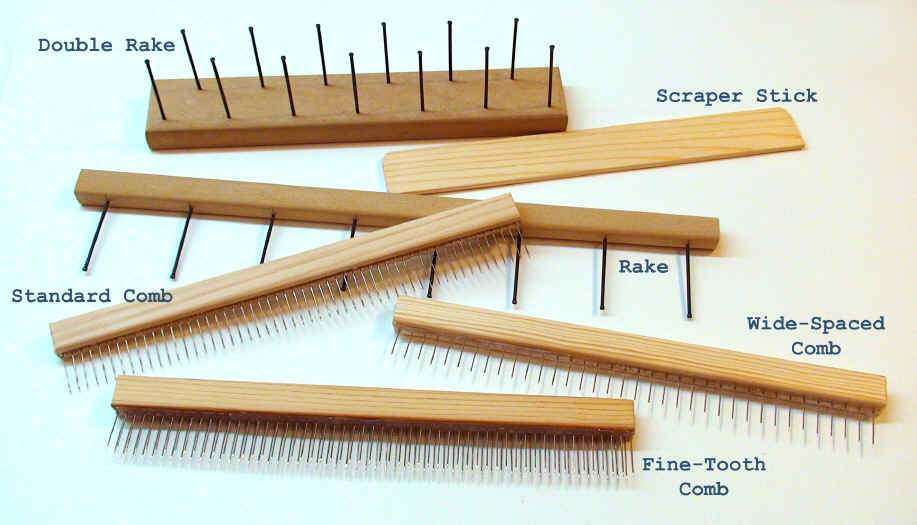
Combs help us create different patterns depending on the distance between needles. You can create lines and a nice background. While it’s not super easy to find an original wooden comb, you can always use a plastic alternative like this water marbling painting comb.
Ebru Needle


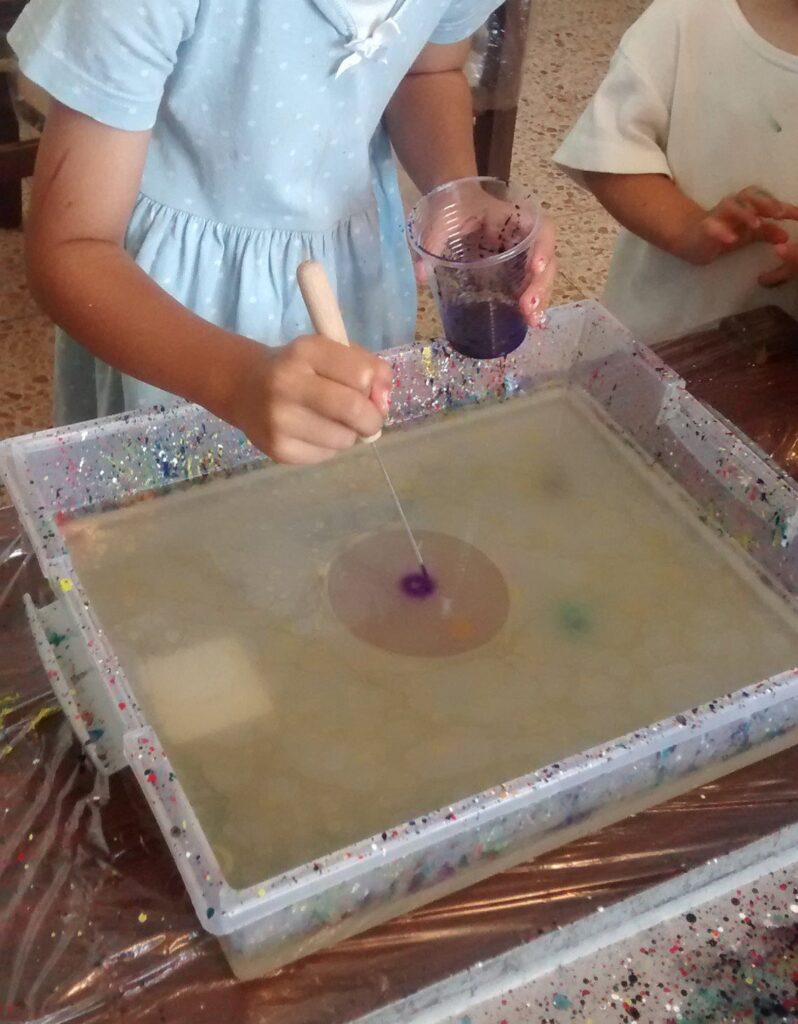
It is a must-have tool to create patterns, shapes, and lines. Needles can have various thicknesses and forms: a 5 petals tool is great for drawing flowers.
Can be also called awls.
They always come together with marbling or ebru kits but are hard to buy separately.
Additional Tools For Ebru
Brushes for ebru
With ebru, we use natural brushes, made with horsehair or hog. Brushes allow us to create another pattern, different from combs and sticks – they can hold more paint and create many small drops when we strike the brush:
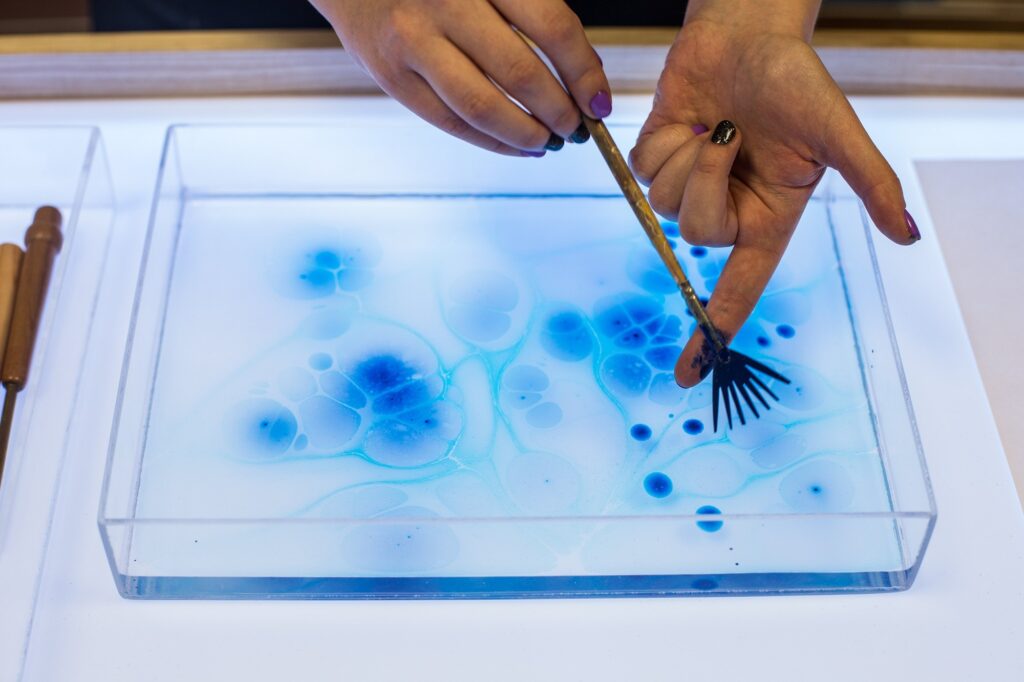
Burnishing tool
The burnishing tool helps to polish and make the dried painting flat.
- Press the burnishing tool against the paper
- Rub it over the painting
Today, almost no one use burnishing, the easy alternative is to place a stone or glass weight on the marbled paper.
Turpentine
Turpentine is used to give a three-dimensional look to ebru painting. For ebru painting, we should only use natural turpentine.
Get a separate brush for it.
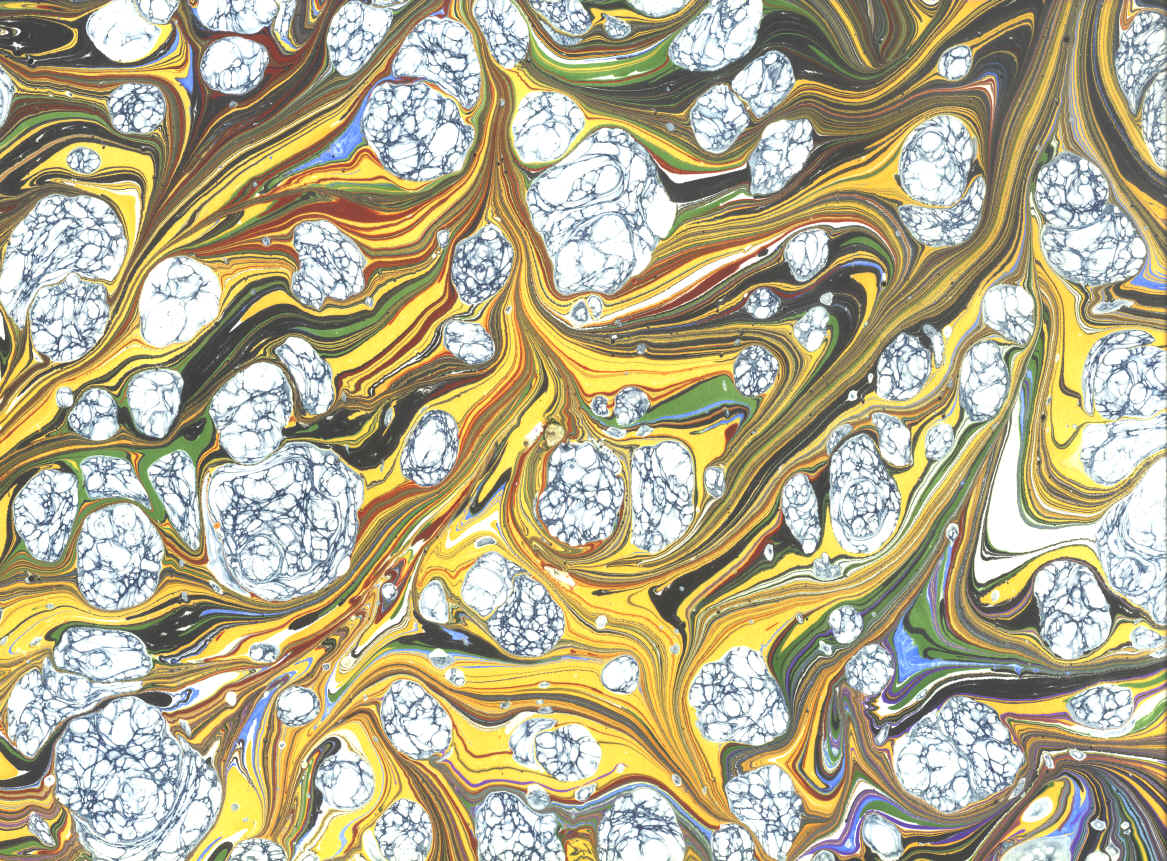
Alum
Some artists cover paper with alum solutions to make it more sensitive to paint. In this case, you need to mix water with aluminum sulfate and apply a layer to your paper.
How to make Ebru painting at home
Ebru is time-consuming but extremely enjoyable!
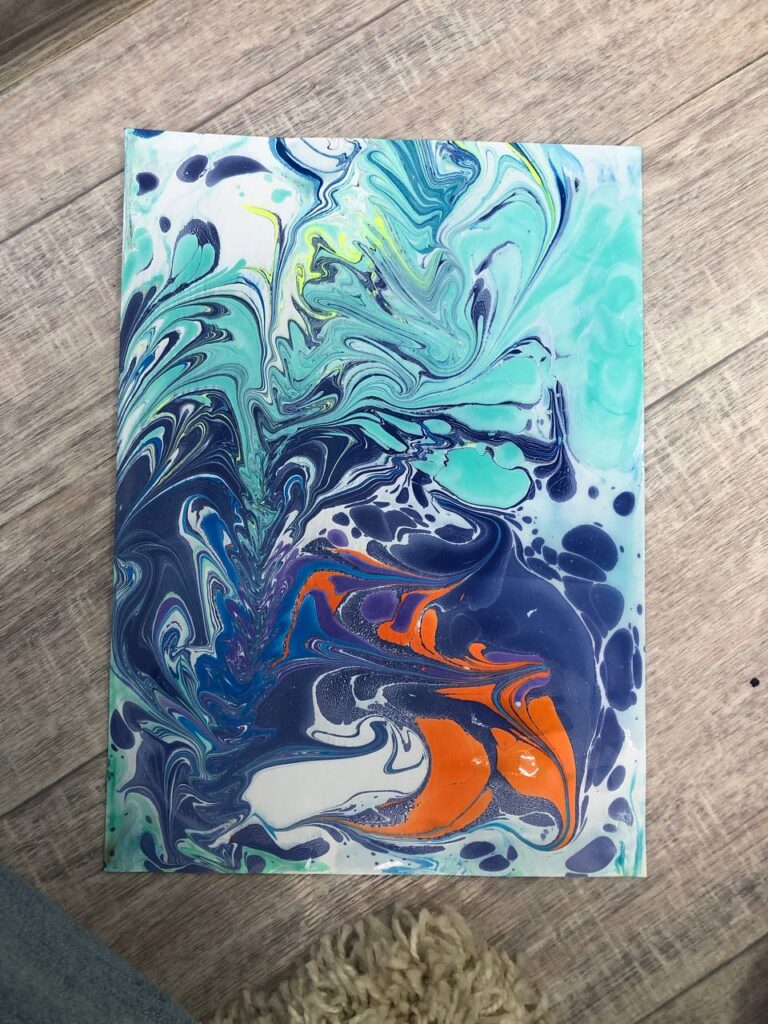
- Prepare your tray, clean and dry
- Prepare your paper: apply an alum solution (water mixed with aluminum sulfate) to make sure the paint will adhere to it.
- Dry papers for at least 2-3 hours.
- Mix carrageenan with water using a blender: 1/4 cup (sifted) of powder for 5 liters of water which makes one 12×18 full tray of solution. Some manufacturers recommend distilled water, some – hot tap water, read instructions carefully.
- Fill the tray to a depth of at least 1″ and let it sit for a few hours (up to 6 hrs)
- Prepare your paint. If you are a beginner, just use pre-mixed paint.
- Paint: add small drops of each other color directly onto the surface, shape them with a comb or needle. Add more colors
- When your painting is ready, place paper onto the surface very carefully. Few seconds are enough for a pattern to be transferred. Gently, pick the corners and take off the paper, dragging it over the edge of the tray for removing excess paint.
- Let it dry flat
- Place it under heavy books or something to flatten the painting
Some of my ebru paintings
I’ve used mostly needles to create all of these ebru designs
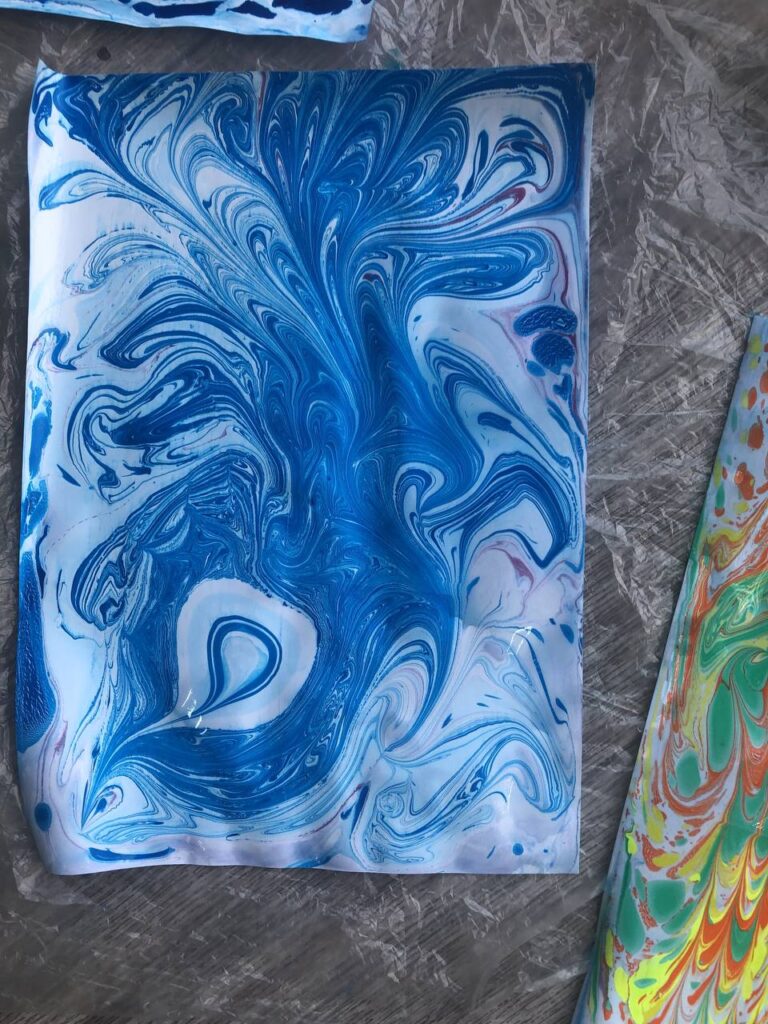

Ebru Art Styles
Two major ebru styles are Traditional and Floral ebru. Traditional Hatip (Orator) Ebru gave birth to the Floral style.
Traditional Ebru – the patterns mostly used by the masters in the known history of Ebru. Some of the main types of traditional Ebru are Battal, Gelgit, Taraklı, Bülbül yuvası, etc:
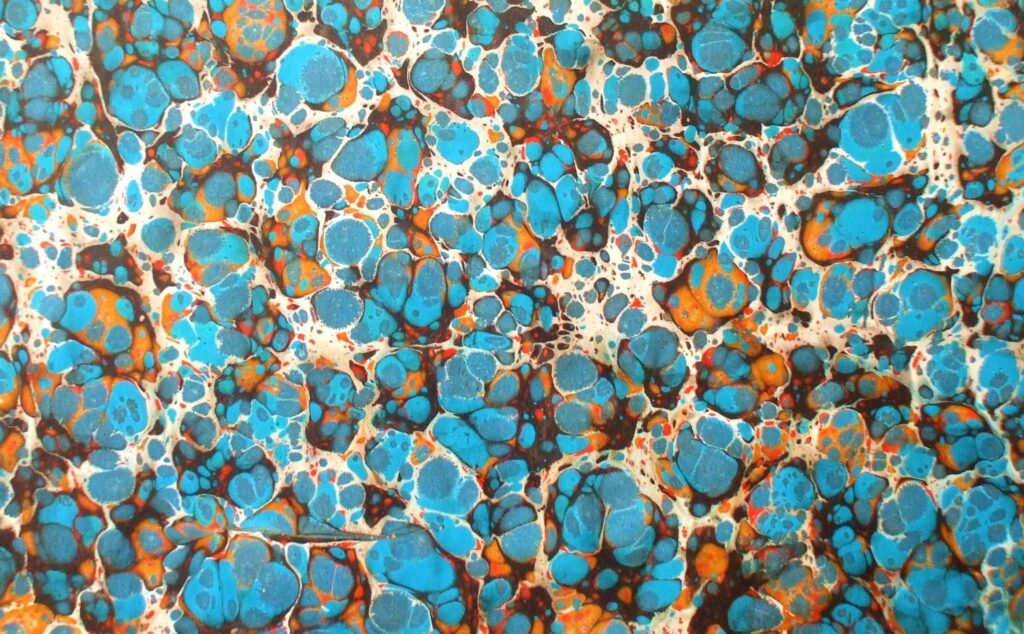
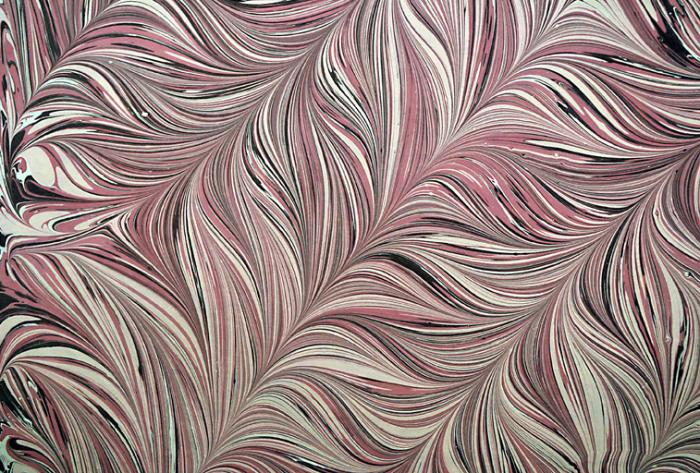
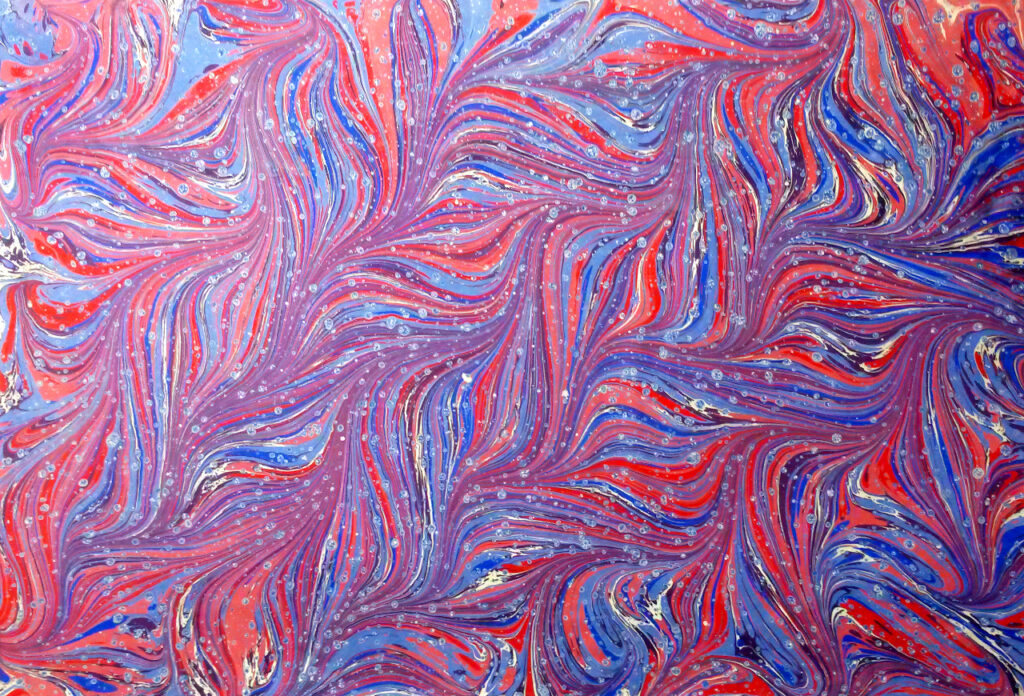
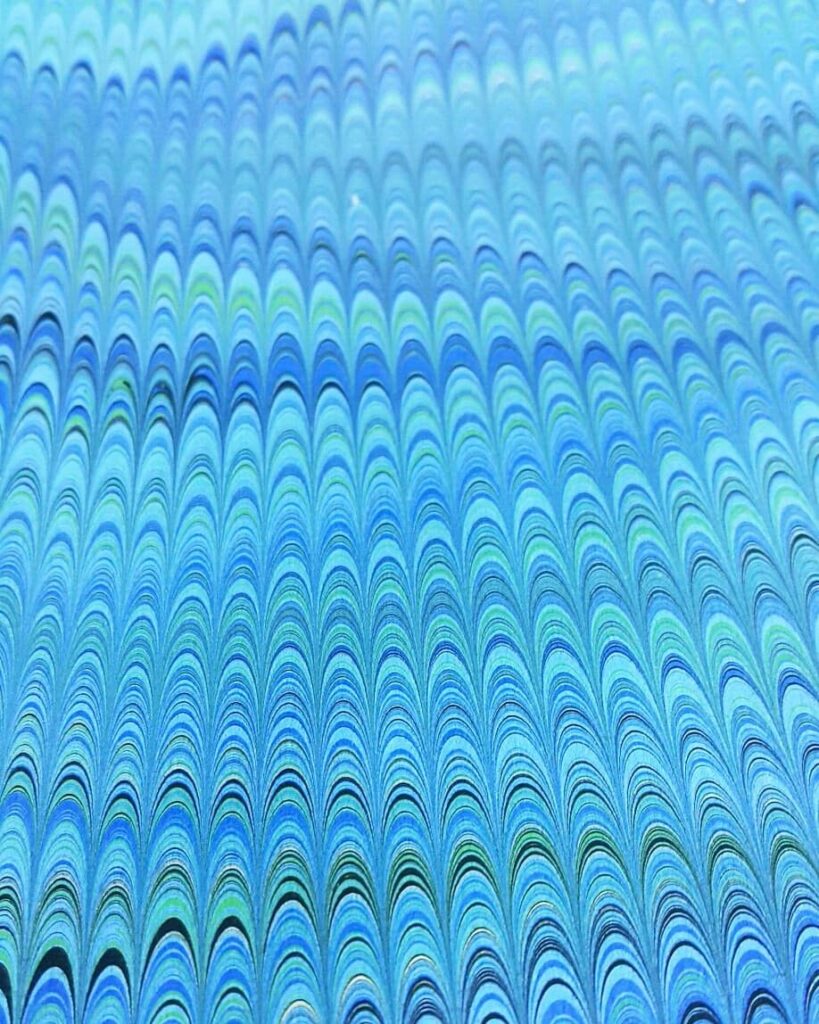
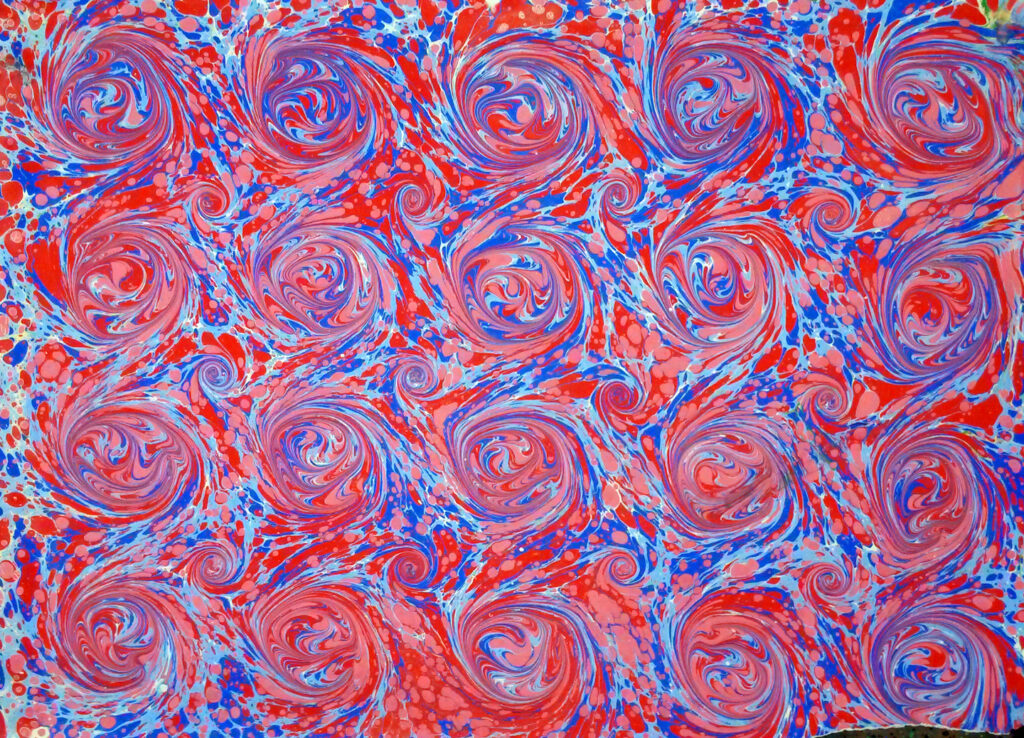

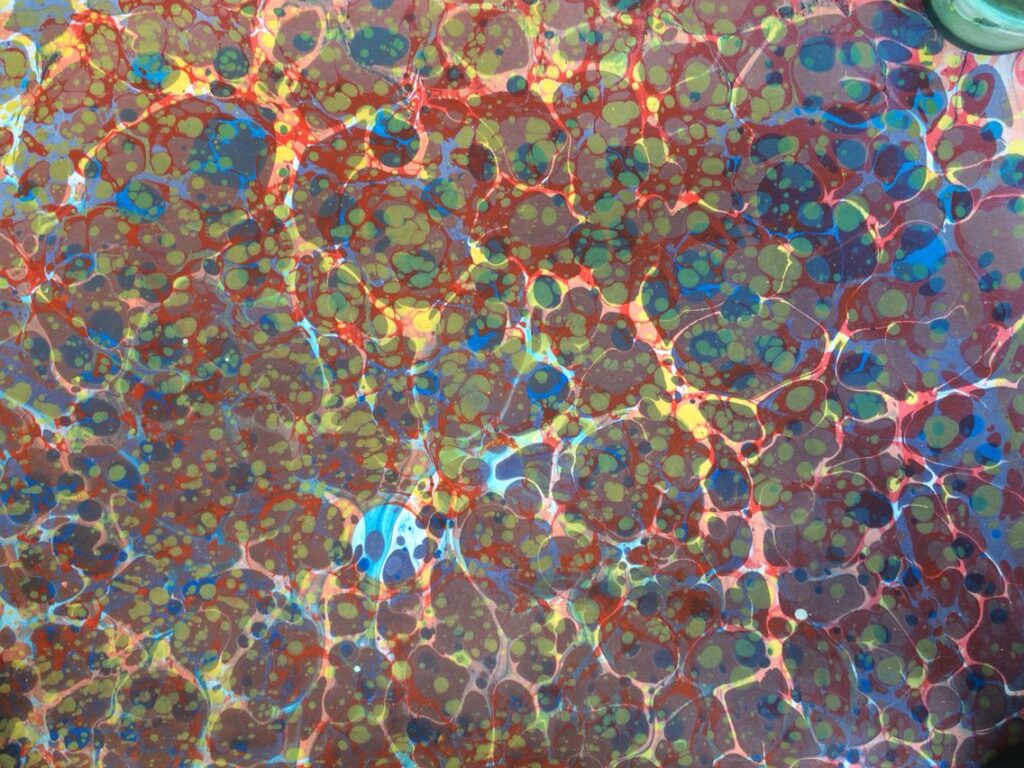
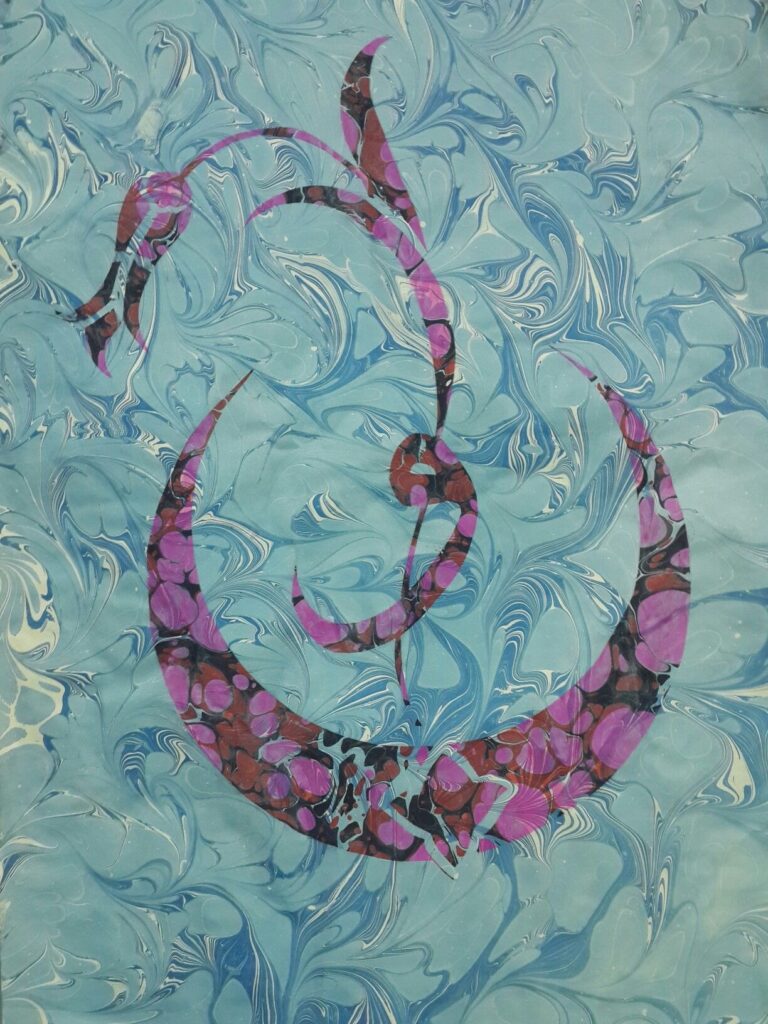

Floral Ebru (Necmeddin Ebruları) helped Ebru’s art to take place among other plastic arts
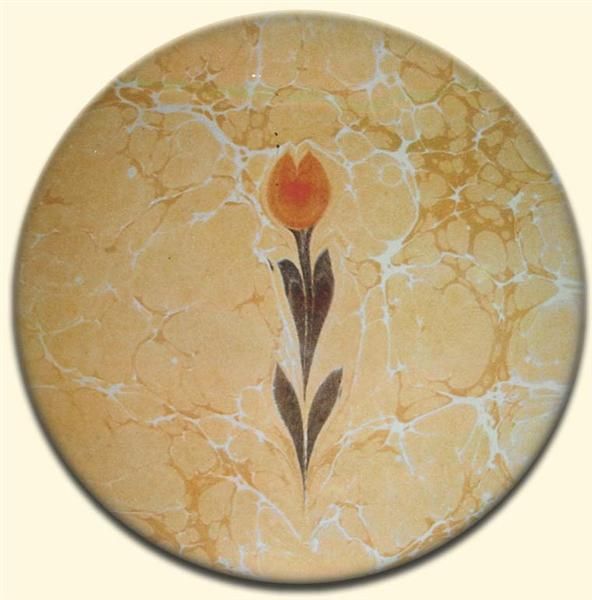
Today I see some studios offering water painting/marbling workshops and it is basically Ebru.
I’ve seen also a DIY solution to make ebru painting at home with shaving cream, but as you can guess it has nothing to do with original Turkish tradition of marbling paper, but can be still fun craft for kids 🙂
Have you ever tried the magic of Ebru? If you have any questions please leave a comment!

Masha Eretnova, born in 1991, is a Buenos Aires-based certified teacher, artist, and member of the Professional Artist Association with 20+ years of personal painting journey.
She started painting and drawing very early and is now an international abstract artist and educator passionate about acrylic painting, gouache, and crafts.
Her works are part of international exhibitions and contests, including ArtlyMix (Brazil), Al-Tiba 9 (Spain), Exhibizone (Canada), Italy, and many more.
Besides her artistic pursuits, Masha holds a post-grad diploma in Teaching Film Photography and 2 music school diplomas: piano and opera singing.
Last update on 2024-07-27 / Affiliate links / Images from Amazon Product Advertising API

